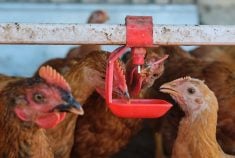Sao Paulo | Reuters—Projections for Brazilian chicken exports this year will likely be revised upward as numerous outbreaks of avian influenza reduce supply in competing exporters and importing nations, a group representing domestic processors said on Tuesday.
ABPA had initially projected Brazil’s 2025 chicken exports reaching up to 5.4 million tons, up 1.9 per cent compared to the previous year.
But based on outstanding sales in the first weeks of the year, that forecast may prove conservative, said Ricardo Santin, head of the group, in an interview.
Read Also

U.S. livestock: CME cattle tick lower in thin pre-holiday trade
Chicago | Reuters – Chicago Mercantile Exchange live and feeder cattle futures were little changed but ended slightly lower on…
“The 5.4 million tons were at the top of the projected range but will likely be revised,” he said, adding more monthly data is required to officially increase the forecast.
Since January 1, more than 34 countries have registered outbreaks of avian influenza, according to data from the World Organization for Animal Health cited by ABPA.
In the United States, Brazil’s main competing exporter, there are more than 60 active outbreaks. There are also 64 outbreaks in the United Kingdom, 76 in Germany, 40 in Poland and 36 outbreaks in the Netherlands, ABPA said.
Brazil never had an outbreak on a commercial farm.
In January, Brazilian chicken shipments increased by almost 10 per cent, driven by increased demand from China, the European Union and the Philippines.
Strong demand drove a 20.9 per cent increase in chicken export revenue.
“February should be no different, based on the weekly partial figures received, which predict shipments of over 450,000 (tons),” ABPA’s statement said.
The first half of the year tends to be seasonally weaker than the second, Santin said, adding initial export performance may boost Brazil’s overall export volumes on a monthly basis at the end of 2025.















